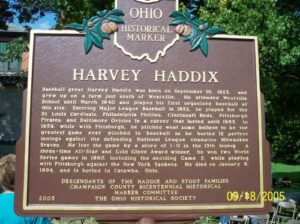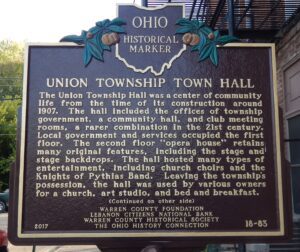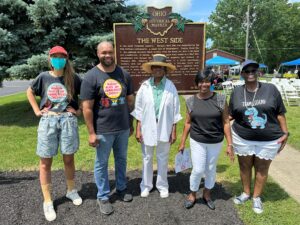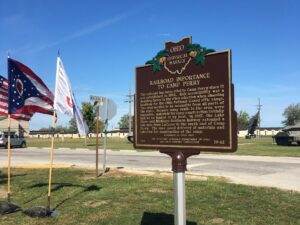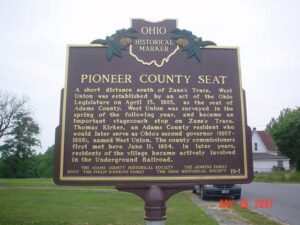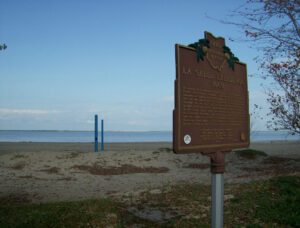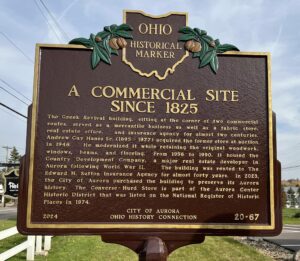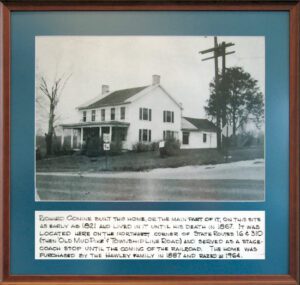, OH
Baseball great Harvey Haddix was born on September 18, 1925, and grew up on a farm just south of Westville. He attended Westville School until March 1940 and played his first organized baseball at this site. Entering Major League Baseball in 1952, he played for the St. Louis Cardinals, Philadelphia Phillies, Cincinnati Reds, Pittsburgh Pirates, and Baltimore Orioles in a career that lasted until 1965. In 1959, while with Pittsburgh, he pitched what some believe to be the greatest game ever pitched in baseball as he hurled 12 perfect innings against the defending National League champion Milwaukee Braves. He lost the game by a score of 1-0 in the 13th inning. A three-time All-Star and Gold Glove Award winner, he won two World Series games in 1960, including the deciding Game 7, while playing with Pittsburgh against the New York Yankees. He died on January 8, 1994, and is buried in Catawba, Ohio.
, OH
The Union Township Hall was a center of community life from the time of its construction around 1907. The hall included the offices of township government, a community hall, and club meeting rooms, a rarer combination in the 21st century. Local government and services occupied the first floor. The second floor “opera house” retains many original features, including the stage and stage backdrops. The hall hosted many types of entertainment, including church choirs and the Knights of Pythias Band. Leaving the township’s possession, the hall was used by various owners for a church, art studio, and bed and breakfast.(Continued on other side)
, OH
In the early twentieth century, Marion’s West Side was dominated by the Erie Railroad switchyards, a major hub of employment. During World War I, the railroad recruited Black workers from the South for jobs in its yards and roundhouses. In Marion, these workers made their homes in a West Side encampment that became the target of white suspicion and violence. In February 1919, following the unsolved murder of a white roundhouse worker’s wife and a separate alleged assault, a 300-man lynch mob smashed windows and occupied the West Side. All Black residents were ordered to leave the city by 6:00 pm the next day. Despite pleas to Governor Cox, at least 200 Black residents were forced to flee Marion. Marion’s anti-Black violence foreshadowed the nationwide “Red Summer” of 1919.
, OH
Railroad Importance to Camp Perry. The railroad has been vital to Camp Perry since it was established in 1906. Rail accessibility was a deciding factor in the site’s selection when choosing locations for the Ohio National Guard rifle range. The area needed to be accessible from all parts of the state. Because many roads in the area were impassible, materials for camp construction initially had to be hauled in by boat. In 1907, the Lake Shore and Michigan Southern Railway extended a rail spur from LaCarne to the south end of Camp Perry. The spur eased delivery of materials and laborers for construction of the camp. (Continued on other side)
, OH
The Adams County Fairgrounds, established at this site in October 1853, on seven acres of land donated by Judge George Collings, was converted to a Civil War training camp named in honor of General Thomas Hamer, a Mexican War hero, of Georgetown, Ohio. The old stone Courthouse was made into a hospital to serve the camp. The 70th Ohio Volunteer infantry, organized in October 1861, trained on the old fairgrounds until Christmas day 1861, when it marched from Camp Hamer to Ripley. The 70th participated in the battles of Shiloh, Tennessee; Atlanta, Georgia; the siege at Vicksburg, Mississippi, and Sherman’s March to the Sea.
, OH
In search of a westward-flowing river, French explorer and trader Rene-Robert Cavelier, Sieur de La Salle (1643-1687) mounted an inland expedition from the south shore of Lake Erie at the mouth of the Grand River in the fall of 1669. Thought to be the first European to see the Ohio River, La Salle journeyed up the Grand River and portaged to a tributary of the Ohio; from there he descended as far as the falls at Louisville, Kentucky. La Salle’s explorations both expanded the fur trade and helped to consolidate French claims to the Mississippi River valley. French dominance in Ohio ended following British victory in the French and Indian War (1754-1763).
, OH
James Willard Converse (1806-1892) opened his store in 1825 at 10 South Chillicothe Road. Serving residents, merchants, and travelers, the store proved central to Aurora’s early commercial development. Converse’s Daybook survives as a glimpse into the habits of early citizens, who, along with household items, regularly purchased whiskey. Surprisingly, such sales surged on George Washington’s February 22 birthday. Converse deeded the business to employee Seth A. Gillett in 1834. Hopson Hurd Sr. (1793-1869) purchased it from Gillett in 1845. Hurd’s store was popular with local farmers who used their home made cheese as legal tender and enjoyed the barrel of whiskey kept in Hurd’s basement for customers who paid their bills. Hurd added a cheese warehouse to his store and, as a major exporter of cheese to Cleveland, Warren, and Pittsburgh, amassed a sizeable fortune.
, OH
Born in New Jersey, Richard and Sarah Conine, the founders of the village of Pataskala, moved to Lima Township and lived on this site as early as 1821 when Richard established a grist mill nearby. Their homestead also served as a stagecoach stop on the mud pike between Columbus and Newark prior to the coming of the railroad. Richard platted “Conine Town” south and west of here in 1851, and the town was renamed Pataskala soon after. The public-spirited Conines contributed to the building of several area schools and churches and donated land for the Pataskala Cemetery. After their deaths, Sarah’s nephew Jacob Van Dorn inherited the property. John Hawley purchased the home in 1887 and for many years it was known as “The Hawley House.” It was demolished in 1964 to make way for commercial development.


